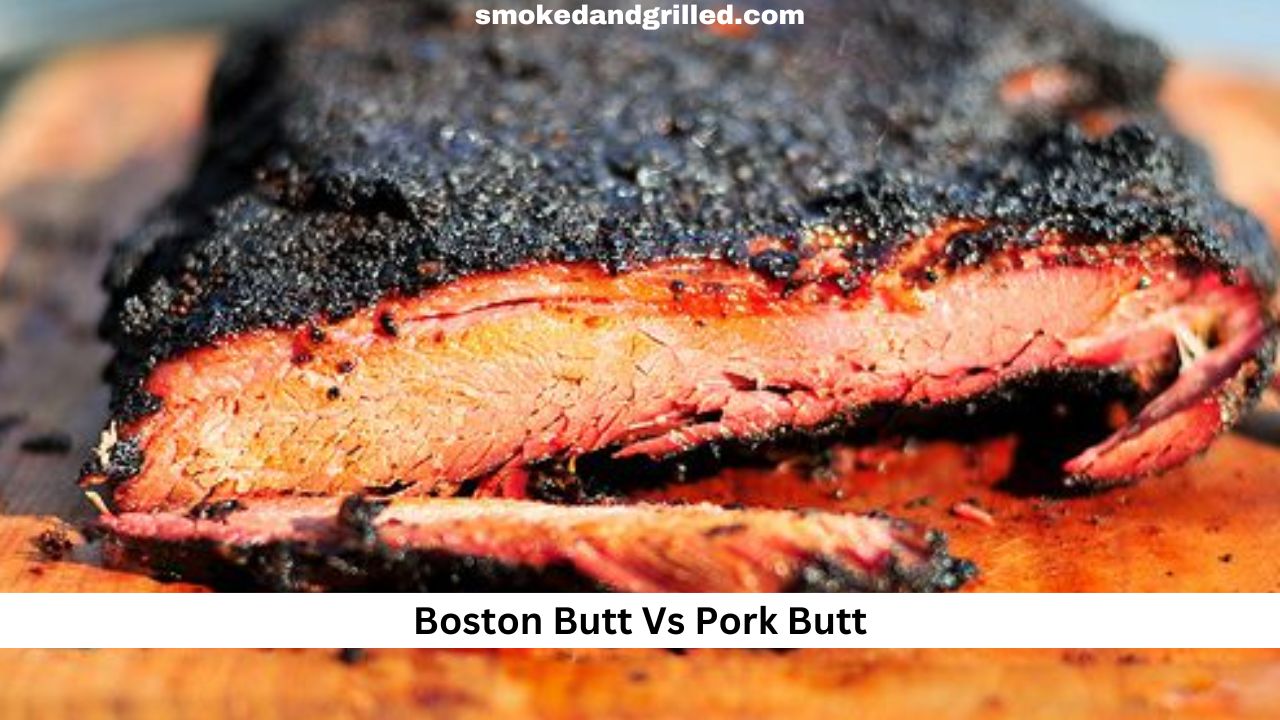Do you want to know the distinction between pork butt and Boston butt? In that case, you’ve found the right site!
Both types of meat come from the same cut of pork, but they differ in preparation and cooking time.
The Boston Butt is taken from the upper portion of the pork’s shoulder, while the Pork Butt comes from the lower part.
We will examine both pork slices in this blog article and contrast their qualities, applications, and more.
From the basics like texture and taste to cooking tips for each cut of meat—this post has it all! So if you want to learn more about these two types of pork butts, then keep reading!
What Is A Boston Butt?
A piece of pork from the upper part of the shoulder is known as a Boston Butt. It has a marbled texture and contains fatty deposits, making it ideal for low and slow cooking.
Many southern states like Alabama and Mississippi use this cut to make pulled pork by slow roasting it at low temperatures until the meat falls off the bone and can be shredded or ripped apart.
No matter what name you choose to call it, one thing is for sure: The Boston Butt is an incredibly versatile piece of meat perfect for many home-cooked meals!
Also Read: Does Smoked Salmon Need to Be Cooked?
What Is A Pork Butt?
That it was stored in after being packed. Grocery stores began labeling it pork butt on their inventory lists.
Its marbled texture makes it an ideal pick when slow cooking, as the fat helps to keep the pork moist and tender while adding extra flavor.
Crispy pork jowl or crispy skin are the most popular ways to prepare pork butt, which can be removed after cooking for added texture!
What Is The Difference Between A Boston Butt And Pork Butt?
The terms “Boston butt” and “pork butt” may sound similar, but there is an essential distinction between them. Here are the following distinctions:
1- Appearance:
On the other hand, pork butt is a bone-in cut taken from the top half of the shoulder.
This cut has a generous layer of fat that results in moist and succulent meat – but with not nearly as much flavor as a Boston butt.
Because these two cuts are from different parts of the same animal, they have slightly different appearances.
2- Cooking Time:
Cooking time can vary significantly between Boston Butt and Pork butt depending on several factors, such as the size of the cut, the method of cooking, and the desired doneness.
Oven roasting a Boston Butt will take about 45 minutes per pound at 350°F for medium-rare to medium doneness.
Cutting your butt into smaller pieces before cooking can help ensure an even temperature for more evenly cooked meat and a quicker cook time.
3- Price:
A Boston Butt, also known as a shoulder roast, is the thicker portion of the shoulder cut and is typically more expensive than a Pork Butt.
Both are flavorful cuts of meat that provide great texture when cooked correctly, so whether you opt for one or the other entirely depends on what your culinary needs demand.
Usually, the Boston Butt contains muscle and fat, adding flavor to dishes like slow-cooked pulled pork.
In contrast, Pork Butts are boneless and only include meat, making them ideal for chopping into chunks for flavorful pork tacos.
4- Fat Content:
The Boston butt has slightly longer fat lines running through it since it is higher up on the animal, while the pork butt tends to be more marbled and has shorter fat streaks.
When purchasing either cut of meat, check that the texture and coloring are consistent from one part to another. This will ensure that you’re purchasing premium-quality cuts for your recipe.
5- Cooking Methods
Generally speaking, the pork butt is more difficult to work with due to its smaller size – many cooks opt to marinate it ahead of time or use moist-heat cooking methods such as braising or simmering in liquid.
Although both cuts have unique characteristics that make them desirable for different situations and recipes, understanding their differences will help any cook choose the best cooking method.
6- Taste
Boston Butt and Pork butt have a savory, slightly sweet flavor unique to pork.
Since the Boston Butt has more marbling throughout, it tends to be more moist and succulent when cooked than the pork butt, which can be slightly drier due to its lower fat content.
Which Is Better, A Boston Butt Or A Pork Butt?
Deciding between a Boston Butt and a Pork Butt can be tricky, as they both come from the same cut of pork – the shoulder.
The difference lies in their regional names: a Boston Butt, so-named due to its popularity in Massachusetts and other New England states, is called a Pork Butt in many different areas.
Some chefs prefer the Boston Butt because of its slightly higher fat content, which results in juicy, tender pulled pork sandwiches.
Others prefer Pork Butts for their firm texture that holds up well when diced into tacos or tucked into burritos.
Whichever cut you choose, cooking your butt low and slow creates tender goodness that everyone will enjoy!
Which One Is Better For Pulled Pork?
Boston Butt and Pork Butt make an excellent choice for pulled pork; the main difference is their fat content.
This can be a great option if you’re looking for less fat but still want juicy and succulent pulled pork sandwiches!
Ultimately, both cuts will produce delicious results; their choice comes down to personal preference.
No matter which cut of pork butt you choose, one thing is certain: you’re in for an incredibly delicious and unique meal sure to please everyone at the table.
How to Cook a Boston Butt or pork butt?
Cooking a Boston butt, or pork butt, can be intimidating, but with these few easy steps, you’ll have a delicious dish!
- First, season the Boston butt with your favorite mix of herbs and spices.
- Next, please place it in the oven at 350°F for about 30 minutes per pound.
- Turn the meat over once halfway through cooking to ensure that all sides are fully cooked.
- Once finished cooking in the oven, add 1/3 cup of apple cider vinegar to a pot and place the porkbutt in sealing it tightly with foil.
- Simmer on low heat for 2 hours until the outside layer is tender to a fork’s touch.
- Lastly, remove from the pot, unwrap, and enjoy!
With a tasty onion or garlic marinade and some added heat during cooking, your Boston butt will taste amazing!
How To Pull Pork Boston Butt?
Pulled pork Boston Butt is surprisingly easy to make and requires minimal effort for maximum flavor. First, season the pork shoulder with a rub of your choice.
Allow it to marinate overnight in a refrigerated container to bring out its flavors. Preheat your oven to 225 degrees the next day and place the roast on an aluminum foil-lined baking tray.
Cook for 8 hours at this low temperature, turning it periodically if desired.
When the internal temperature of the pork reaches 165 degrees Fahrenheit, carefully remove it from the oven and shred the pork into small pieces using two forks.
Poof! Delicious pulled pork Boston Butt is ready; serve with your favorite side dishes or sandwiches!
Can You Substitute Pork butt for Boston butt?
Yes, you can! The two cuts are from the same muscle and can be interchanged in any recipe.
Keep in mind that if your recipe calls for a specific type of pork butt, choose the right one, as they differ in flavor profiles. Pork butt or Boston butt, either way, you can’t go wrong with this tasty option!
What Are Some Common Uses For Leftover Boston Butt?
There are many different ways to use leftover Boston butt. One popular method is to shred the meat and use it in pulled pork sandwiches.
Another everyday use for leftover Boston butt is to dice it up and use it in soups or stews. Enjoy whatever you do with your leftovers within 3-4 days for the best quality.
Tips For Cookingboston Butt
Here are some tips to help you cook the perfect Boston butt:
1- Make sure your smoker or grill is preheated before adding your pork butt. This will help to ensure that it cooks evenly throughout.
2- Use a digital thermometer inserted into the thickest part of the meat to check its internal temperature during cooking. You want it to reach an internal temperature of at least 145 degrees Fahrenheit to be safe to eat.
3- Allow your pork butt to rest for at least 10 minutes after cooking before slicing or serving it. This will allow the juices to redistribute throughout the meat, resulting in juicier and more flavorful slices
Conclusion
Regarding butchery, a critical difference between Boston and Pork Butts is the size of their cut.
Depending on where you live, these cuts can be referred to by different names, but the distinctions remain – Boston Butt is more significant than pork butt, for onewhichre fat content.
For Boston Butt, however, dry-heat cooking methods are typically preferred as they lend themselves better to longer cooking times; because of their great fat content, this cut of meat can be seared and roasted quickly without drying out.
Although both cuts have unique characteristics that make them desirable for different situations and recipes, understanding their differences will help any cook choose the best cooking method.
Also Read: What Should Sausage Internal Temperature Be At? (Pork, Beef, And Other Meat)



